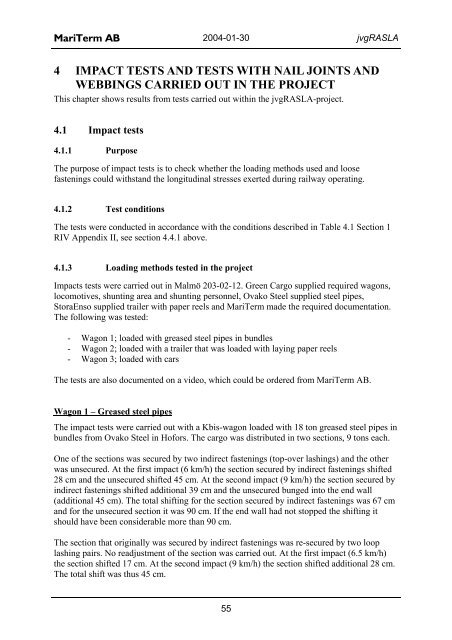Equipment for Rational Securing of Cargo on Railway ... - Vinnova
Equipment for Rational Securing of Cargo on Railway ... - Vinnova
Equipment for Rational Securing of Cargo on Railway ... - Vinnova
You also want an ePaper? Increase the reach of your titles
YUMPU automatically turns print PDFs into web optimized ePapers that Google loves.
MariTerm AB 2004-01-30 jvgRASLA<br />
4 IMPACT TESTS AND TESTS WITH NAIL JOINTS AND<br />
WEBBINGS CARRIED OUT IN THE PROJECT<br />
This chapter shows results from tests carried out within the jvgRASLA-project.<br />
4.1 Impact tests<br />
4.1.1 Purpose<br />
The purpose <str<strong>on</strong>g>of</str<strong>on</strong>g> impact tests is to check whether the loading methods used and loose<br />
fastenings could withstand the l<strong>on</strong>gitudinal stresses exerted during railway operating.<br />
4.1.2 Test c<strong>on</strong>diti<strong>on</strong>s<br />
The tests were c<strong>on</strong>ducted in accordance with the c<strong>on</strong>diti<strong>on</strong>s described in Table 4.1 Secti<strong>on</strong> 1<br />
RIV Appendix II, see secti<strong>on</strong> 4.4.1 above.<br />
4.1.3 Loading methods tested in the project<br />
Impacts tests were carried out in Malmö 203-02-12. Green <str<strong>on</strong>g>Cargo</str<strong>on</strong>g> supplied required wag<strong>on</strong>s,<br />
locomotives, shunting area and shunting pers<strong>on</strong>nel, Ovako Steel supplied steel pipes,<br />
StoraEnso supplied trailer with paper reels and MariTerm made the required documentati<strong>on</strong>.<br />
The following was tested:<br />
- Wag<strong>on</strong> 1; loaded with greased steel pipes in bundles<br />
- Wag<strong>on</strong> 2; loaded with a trailer that was loaded with laying paper reels<br />
- Wag<strong>on</strong> 3; loaded with cars<br />
The tests are also documented <strong>on</strong> a video, which could be ordered from MariTerm AB.<br />
Wag<strong>on</strong> 1 – Greased steel pipes<br />
The impact tests were carried out with a Kbis-wag<strong>on</strong> loaded with 18 t<strong>on</strong> greased steel pipes in<br />
bundles from Ovako Steel in Ho<str<strong>on</strong>g>for</str<strong>on</strong>g>s. The cargo was distributed in two secti<strong>on</strong>s, 9 t<strong>on</strong>s each.<br />
One <str<strong>on</strong>g>of</str<strong>on</strong>g> the secti<strong>on</strong>s was secured by two indirect fastenings (top-over lashings) and the other<br />
was unsecured. At the first impact (6 km/h) the secti<strong>on</strong> secured by indirect fastenings shifted<br />
28 cm and the unsecured shifted 45 cm. At the sec<strong>on</strong>d impact (9 km/h) the secti<strong>on</strong> secured by<br />
indirect fastenings shifted additi<strong>on</strong>al 39 cm and the unsecured bunged into the end wall<br />
(additi<strong>on</strong>al 45 cm). The total shifting <str<strong>on</strong>g>for</str<strong>on</strong>g> the secti<strong>on</strong> secured by indirect fastenings was 67 cm<br />
and <str<strong>on</strong>g>for</str<strong>on</strong>g> the unsecured secti<strong>on</strong> it was 90 cm. If the end wall had not stopped the shifting it<br />
should have been c<strong>on</strong>siderable more than 90 cm.<br />
The secti<strong>on</strong> that originally was secured by indirect fastenings was re-secured by two loop<br />
lashing pairs. No readjustment <str<strong>on</strong>g>of</str<strong>on</strong>g> the secti<strong>on</strong> was carried out. At the first impact (6.5 km/h)<br />
the secti<strong>on</strong> shifted 17 cm. At the sec<strong>on</strong>d impact (9 km/h) the secti<strong>on</strong> shifted additi<strong>on</strong>al 28 cm.<br />
The total shift was thus 45 cm.<br />
55
















